Today we share with you the well-known LRU algorithm. The first lecture consists of four sections.
- Overview of LRU
- LRU usage
- LRU implementation
- Overview of Redis Near LRU
Part I: Overview of LRU
LRU is an abbreviation for Least Recently Used, translated as least recently used.Its rationale is that "recently used data will remain in use for some time to come, and the probable rate of data that has not been used for a long time will not be used for a long time to come", because this idea fits well with business scenariosAnd can solve many practical development problems, so we often use the idea of LRU to cache, commonly referred to as LRU cache mechanism.Because it happens to be on leetcode, I'll just post it here.But for LRU, I hope you are not confined to this topic (you don't have to worry about not learning, I hope to make the simplest version of the whole network, I hope you can keep it up!)Next, let's learn together.
Title: Design and implement an LRU (least recently used) cache mechanism using data structures that you have mastered.It should support getting the data get and writing the data put.
Get Data (key) - If the key exists in the cache, get the value of the key (always positive), otherwise return -1.
Write data put(key, value) - If the key does not exist, its data value is written.When the cache capacity reaches its maximum, it should delete the least recently used data value before writing new data, thereby leaving room for new data values.
Advanced: Can you do both in O(1) time complexity?
Example:
LRUCache cache = new LRUCache( 2 / Cache capacity / );
cache.put(1, 1);
cache.put(2, 2);
cache.get(1); // Return 1
cache.put(3, 3); // This operation will invalidate key 2
cache.get(2); // Return to -1 (not found)
cache.put(4, 4); // This operation will invalidate key 1
cache.get(1); // Return to -1 (not found)
cache.get(3); // Return 3
cache.get(4); // Return 4
Part 2: LRU usage
Let's start by explaining an example of LRUCache.
- Step 1: We declare an LRUCache of length 2

- Step 2: We put(1,1) and put(2,2) inside the cache, respectively, where 2 is first and 1 is last because 2 is recently used (put is also counted as use).

- Step 3: We get(1), which means we use 1, so we need to move 1 ahead.

- Step 4: At this point we put(3,3), because 2 is the least recently used, we need to scrape 2.If we get(2) again, we will return to -1.

- Step 5: We will continue putting (4,4), similarly we will scrap 1.At this point, if get(1), it also returns -1.

- Step 6: At this point we get(3), which actually adjusts the position of 3.

- Step 7: Same as get(4), continue to adjust position of 4.
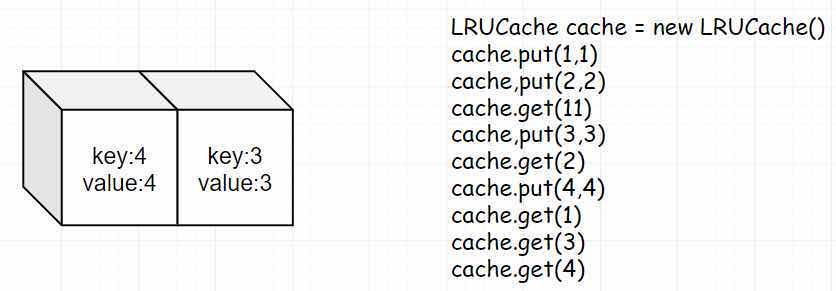
Part Three: LRU Implementation (Layer by Layer)
Through the above analysis, you should be able to understand the use of LRU.Now let's talk about implementation.LRU is generally implemented using a two-way Chain table.I want to emphasize here that this is not absolutely the case in the project.For example, in Redis source code, the elimination strategy of LRU does not use a two-way Chain table, but uses a way to simulate the chain table.Since Redis is mostly used when memory is in use (I know it can be persisted), maintaining a list in memory adds some complexity and also consumes a little more memory. Later, I'll pull out Redis's source code for you to analyze, let's not go into details.
Back to the topic, why should we choose a two-way chain table to implement it?Looking at the steps above, you can see that throughout the use of LRU Cache, we need to adjust the position of the first and last elements frequently.The structure of the two-way chain table just meets this point (to repeat, I just looked at the source code of groupcache the other day, inside is the RU made with the two-way Chain table, of course it has made some improvements inside.Groupcache is the go version implemented by the author of memcache. If there are readers of go, you can check the source code or get some results.)
Next, we implement it using hashmap + two-way Chain table.
First, we define a LinkNode to store elements.Because it's a two-way Chain table, naturally we want to define pre and next.At the same time, we need to store the key and value of the element below.val, you should all understand, the key is why you need to store the key?For example, when the entire cache is full, we need to delete the data in the map, query through the key in LinkNode, or we cannot get the key.
type LRUCache struct { m map[int]*LinkNode cap int head, tail *LinkNode }
Now with LinkNode, you naturally need a Cache to store all Nodes.We define cap as the length of the cache, and m is used to store elements.head and tail are the beginning and end of the Cache.
type LRUCache struct { m map[int]*LinkNode cap int head, tail *LinkNode }
Next we initialize the entire Cache.Connect the head ers and tail s together when they are initialized.
func Constructor(capacity int) LRUCache { head := &LinkNode{0, 0, nil, nil} tail := &LinkNode{0, 0, nil, nil} head.next = tail tail.pre = head return LRUCache{make(map[int]*LinkNode), capacity, head, tail} }
Probably this is:
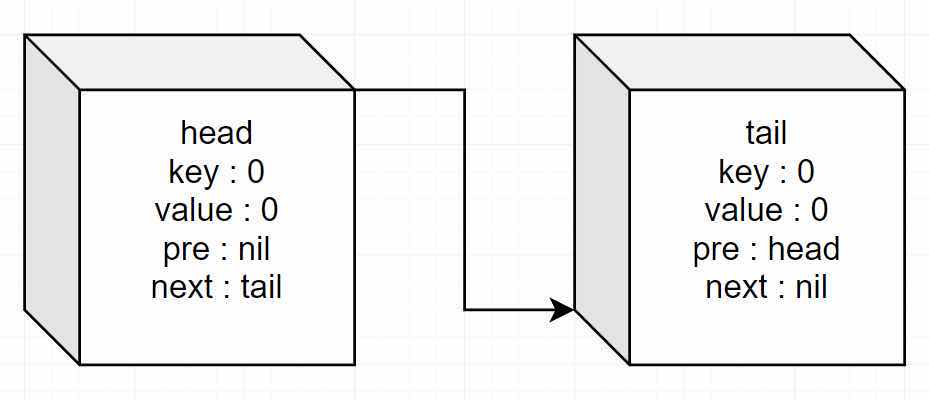
Now that we have constructed the Cache, the rest is to add its API.Because Get is easy, let's finish the Get method first.There are two things to consider here. If no element is found, we return to -1.If an element exists, we need to move it to the top.
func (this *LRUCache) Get(key int) int { head := this.head cache := this.m if v, exist := cache[key]; exist { v.pre.next = v.next v.next.pre = v.pre v.next = head.next head.next.pre = v v.pre = head head.next = v return v.val } else { return -1 } }
Probably like this (assuming 2 is the element of our get)
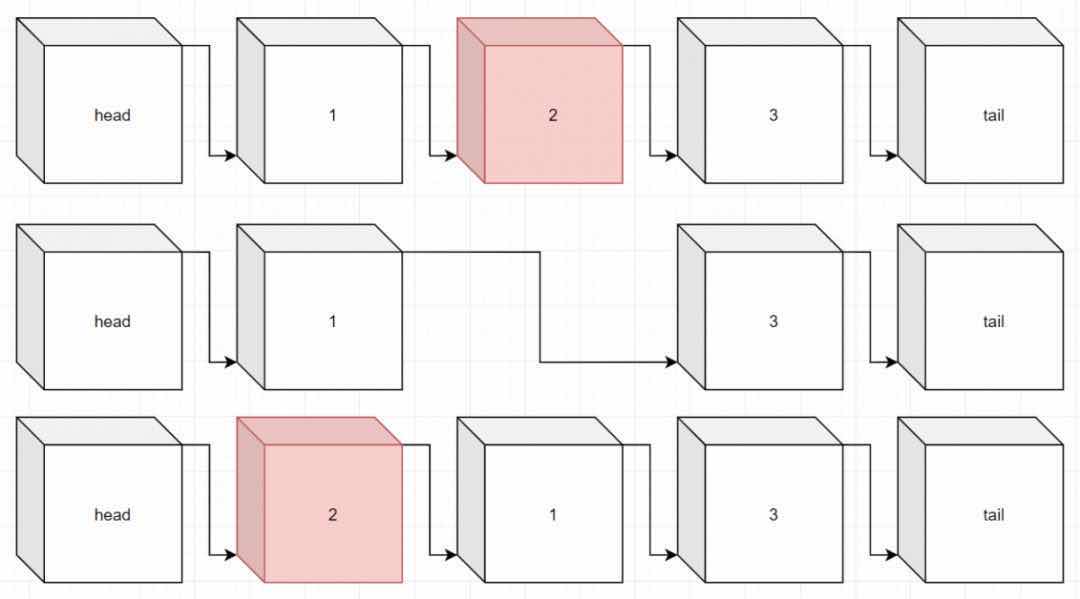
It's easy to think that this method will be used later, so pull it out.
func (this *LRUCache) moveToHead(node *LinkNode){ head := this.head //Remove from current location node.pre.next = node.next node.next.pre = node.pre //Move to first position node.next = head.next head.next.pre = node node.pre = head head.next = node } func (this *LRUCache) Get(key int) int { cache := this.m if v, exist := cache[key]; exist { this.moveToHead(v) return v.val } else { return -1 } }
Now we're starting to finish Put.There are two scenarios to consider when implementing Put.If an element exists, it is actually equivalent to doing a Get operation and moving to the front (but note that there is an additional step to update the value).
func (this *LRUCache) Put(key int, value int) { head := this.head tail := this.tail cache := this.m //If the element exists if v, exist := cache[key]; exist { //1. Update Value v.val = value //2. Move to the front this.moveToHead(v) } else { //TODO } }
If the element does not exist, we insert it at the beginning of the element and place the element value in the map.
func (this *LRUCache) Put(key int, value int) { head := this.head tail := this.tail cache := this.m //existence if v, exist := cache[key]; exist { //1. Update Value v.val = value //2. Move to the front this.moveToHead(v) } else { v := &LinkNode{key, value, nil, nil} v.next = head.next v.pre = head head.next.pre = v head.next = v cache[key] = v } }
But we've missed a situation where the last element needs to be deleted if it happens to be full.Processing is complete, complete code for Put function is attached.
func (this *LRUCache) Put(key int, value int) { head := this.head tail := this.tail cache := this.m //existence if v, exist := cache[key]; exist { //1. Update Value v.val = value //2. Move to the front this.moveToHead(v) } else { v := &LinkNode{key, value, nil, nil} if len(cache) == this.cap { //Delete last element delete(cache, tail.pre.key) tail.pre.pre.next = tail tail.pre = tail.pre.pre } v.next = head.next v.pre = head head.next.pre = v head.next = v cache[key] = v } }

Finally, let's finish all the code:
type LinkNode struct { key, val int pre, next *LinkNode } type LRUCache struct { m map[int]*LinkNode cap int head, tail *LinkNode } func Constructor(capacity int) LRUCache { head := &LinkNode{0, 0, nil, nil} tail := &LinkNode{0, 0, nil, nil} head.next = tail tail.pre = head return LRUCache{make(map[int]*LinkNode), capacity, head, tail} } func (this *LRUCache) Get(key int) int { cache := this.m if v, exist := cache[key]; exist { this.moveToHead(v) return v.val } else { return -1 } } func (this *LRUCache) moveToHead(node *LinkNode) { head := this.head //Remove from current location node.pre.next = node.next node.next.pre = node.pre //Move to first position node.next = head.next head.next.pre = node node.pre = head head.next = node } func (this *LRUCache) Put(key int, value int) { head := this.head tail := this.tail cache := this.m //existence if v, exist := cache[key]; exist { //1. Update Value v.val = value //2. Move to the front this.moveToHead(v) } else { v := &LinkNode{key, value, nil, nil} if len(cache) == this.cap { //Delete end element delete(cache, tail.pre.key) tail.pre.pre.next = tail tail.pre = tail.pre.pre } v.next = head.next v.pre = head head.next.pre = v head.next = v cache[key] = v } }
After optimization:
type LinkNode struct { key, val int pre, next *LinkNode } type LRUCache struct { m map[int]*LinkNode cap int head, tail *LinkNode } func Constructor(capacity int) LRUCache { head := &LinkNode{0, 0, nil, nil} tail := &LinkNode{0, 0, nil, nil} head.next = tail tail.pre = head return LRUCache{make(map[int]*LinkNode), capacity, head, tail} } func (this *LRUCache) Get(key int) int { cache := this.m if v, exist := cache[key]; exist { this.MoveToHead(v) return v.val } else { return -1 } } func (this *LRUCache) RemoveNode(node *LinkNode) { node.pre.next = node.next node.next.pre = node.pre } func (this *LRUCache) AddNode(node *LinkNode) { head := this.head node.next = head.next head.next.pre = node node.pre = head head.next = node } func (this *LRUCache) MoveToHead(node *LinkNode) { this.RemoveNode(node) this.AddNode(node) } func (this *LRUCache) Put(key int, value int) { tail := this.tail cache := this.m if v, exist := cache[key]; exist { v.val = value this.MoveToHead(v) } else { v := &LinkNode{key, value, nil, nil} if len(cache) == this.cap { delete(cache, tail.pre.key) this.RemoveNode(tail.pre) } this.AddNode(v) cache[key] = v } }
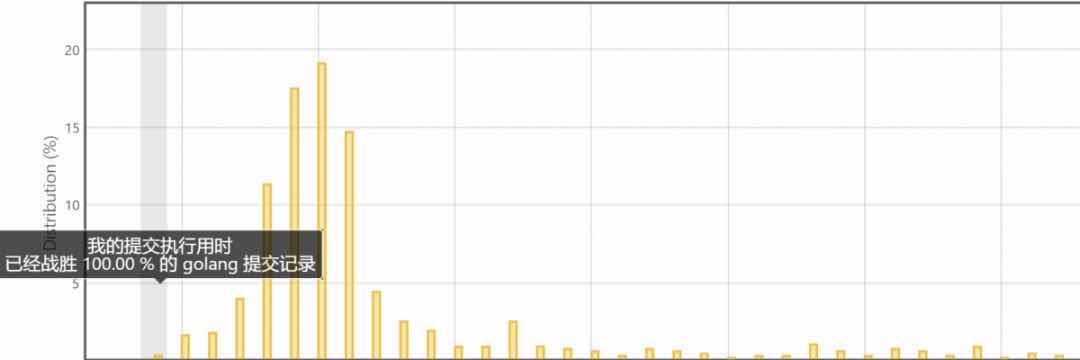
Because the algorithm is too important, give a Java version of the:
//java version public class LRUCache { class LinkedNode { int key; int value; LinkedNode prev; LinkedNode next; } private void addNode(LinkedNode node) { node.prev = head; node.next = head.next; head.next.prev = node; head.next = node; } private void removeNode(LinkedNode node){ LinkedNode prev = node.prev; LinkedNode next = node.next; prev.next = next; next.prev = prev; } private void moveToHead(LinkedNode node){ removeNode(node); addNode(node); } private LinkedNode popTail() { LinkedNode res = tail.prev; removeNode(res); return res; } private Hashtable<Integer, LinkedNode> cache = new Hashtable<Integer, LinkedNode>(); private int size; private int capacity; private LinkedNode head, tail; public LRUCache(int capacity) { this.size = 0; this.capacity = capacity; head = new LinkedNode(); tail = new LinkedNode(); head.next = tail; tail.prev = head; } public int get(int key) { LinkedNode node = cache.get(key); if (node == null) return -1; moveToHead(node); return node.value; } public void put(int key, int value) { LinkedNode node = cache.get(key); if(node == null) { LinkedNode newNode = new LinkedNode(); newNode.key = key; newNode.value = value; cache.put(key, newNode); addNode(newNode); ++size; if(size > capacity) { LinkedNode tail = popTail(); cache.remove(tail.key); --size; } } else { node.value = value; moveToHead(node); } } }
Part 4: Introduction to Redis Near LRU
Now that we have completed our own LRU implementation above, let's talk about the approximate LRU in Redis.Since the real LRU requires too much memory (when there is a large amount of data), Redis uses a random sampling method to achieve an approximate LRU effect.To put it plainly, LRU is simply a model for predicting key access order.
There is a parameter in Redis called "maxmemory-samples". Why?
# LRU and minimal TTL algorithms are not precise algorithms but approximated # algorithms (in order to save memory), so you can tune it for speed or # accuracy. For default Redis will check five keys and pick the one that was # used less recently, you can change the sample size using the following # configuration directive. # # The default of 5 produces good enough results. 10 Approximates very closely # true LRU but costs a bit more CPU. 3 is very fast but not very accurate. # maxmemory-samples 5
As we have said above, approximate LRU is a random sampling method to achieve an approximate LRU effect.This parameter is actually a way for the author to artificially interfere with the size of the sample, and the larger it is, the closer to the effect of the real LRU and, of course, the more memory it consumes.(The initial value of 5 is the author's default best)
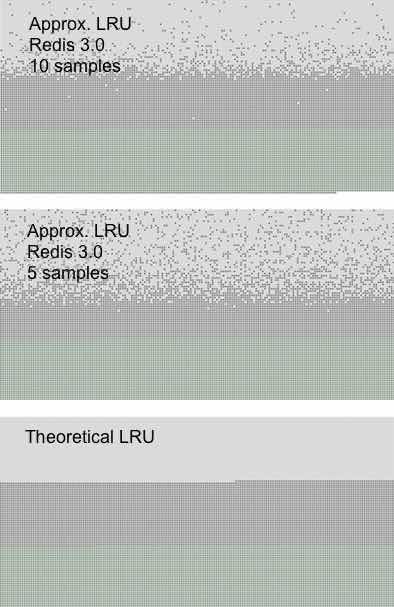
This diagram illustrates that green points are new elements, dark gray points are elements that have not been deleted, and light gray points are deleted elements.The bottom one is a true LRU effect, and the second one is a default LRU effect of 5, so you can see if the light gray part fits the real one or not.The first figure shows the effect of setting this parameter to 10, which is close to that of a real LRU.
Because of the time relationship, this article is basically about this.How does the approximate LRU in Redis work?Please pay attention to the next issue~
Source: This article is authorized to be reloaded by Xiao Hao algorithm